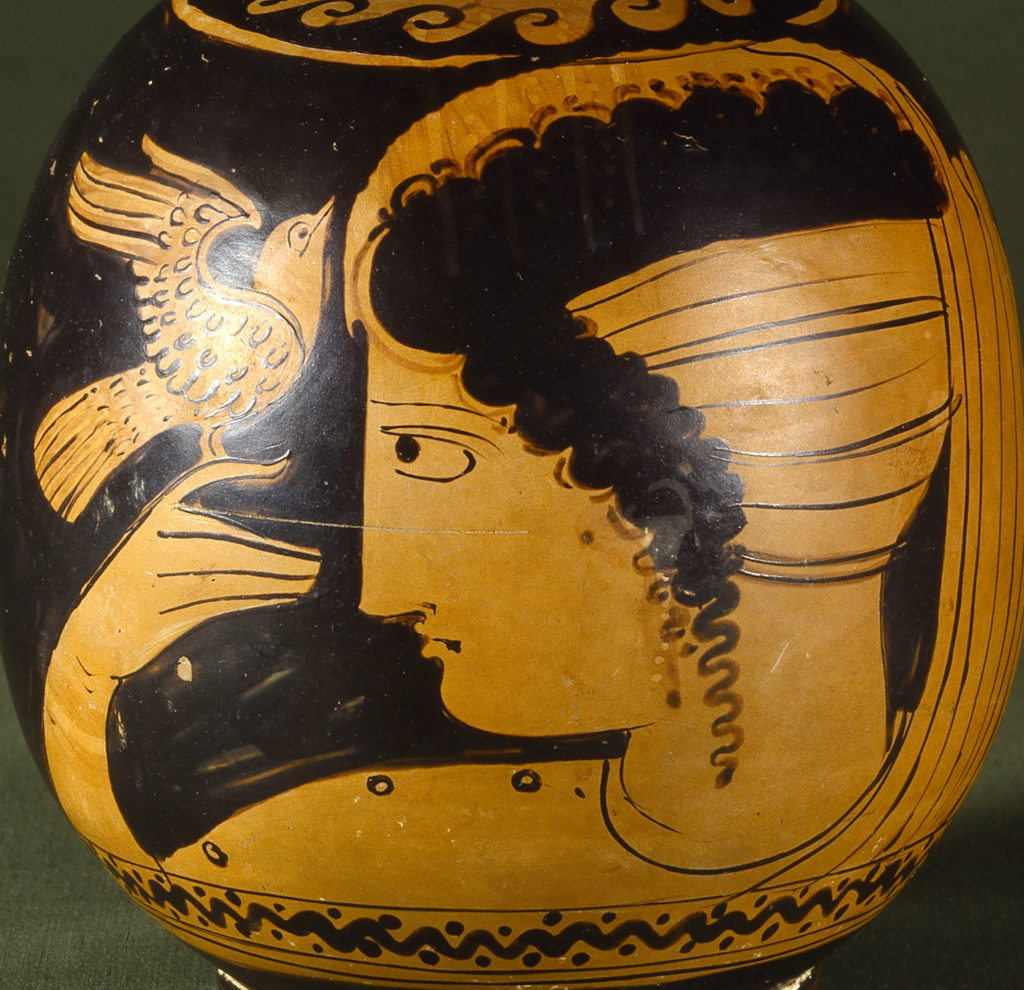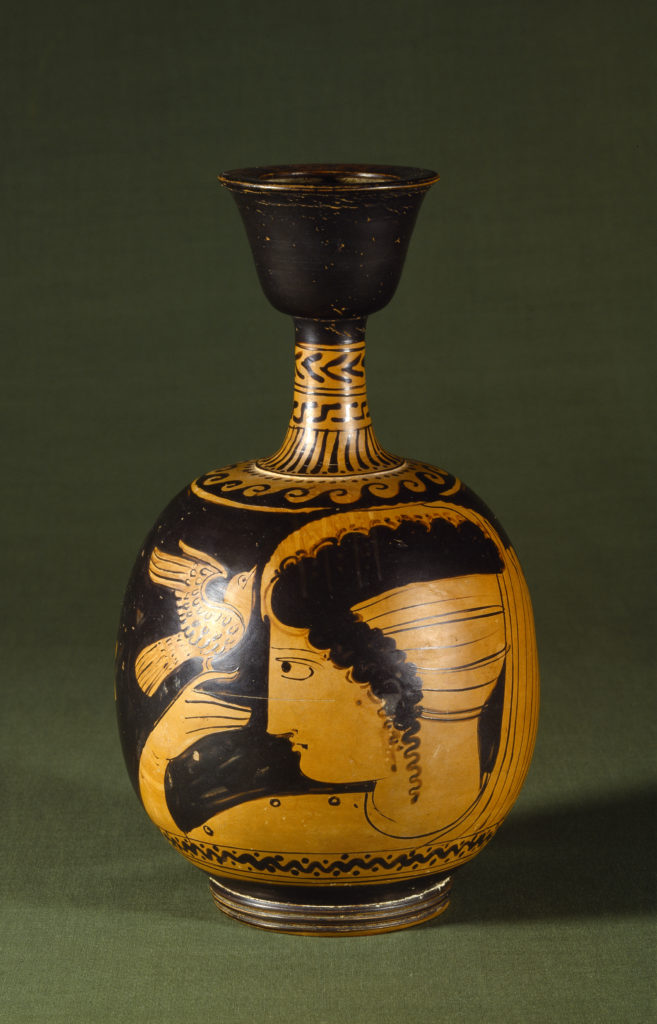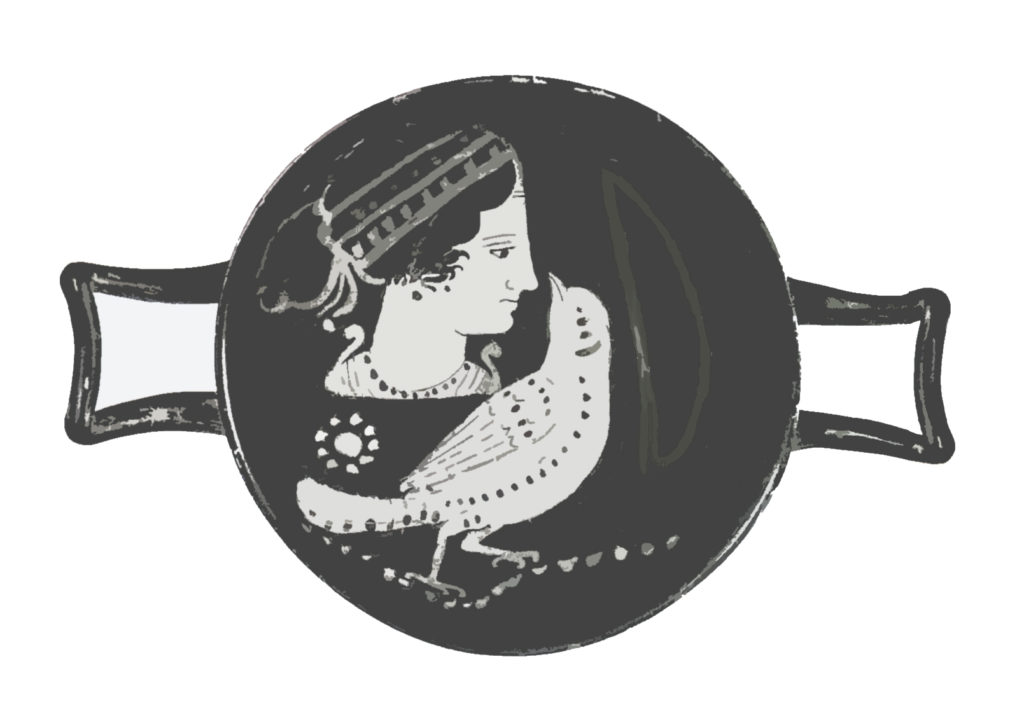2020.12.25 | By Gregory Nagy
§0. In Song 1 of Sappho, as our mind’s eye views Aphrodite, goddess of erotic love, at the moment when she starts driving her chariot pulled by birds called strouthoi and travels with the speed of light, in a miraculous instant, all the way down from the bright heavens above, down to the dark soil of our earthly human existence here below, how are we to imagine these birds of hers? Are they birds in general’ or are they, more specifically, sparrows—to name one special kind of bird? A special meaning that is given for strouthos, when we look up the word in dictionaries, is ‘sparrow’, but a general meaning of ‘bird’ is also attested. So, if we think specifically, we could imagine the birds of Sappho’s Aphrodite either as sparrows or as other special kinds of birds that are not sparrows. I say this because, if we consider the overall evidence of ancient Greek verbal and visual arts, Aphrodite as the goddess of erotic love is traditionally linked not only with sparrows but also with a wide variety of other birds. And, in many cases, the birds of Aphrodite cannot be identified as a special kind of bird, as a species. A case in point is the picture I have chosen as illustration for the cover of this essay. This picture, painted on a lekythos from South Italy, shows a girl gazing at a little bird that is perched on her finger. In this case, there are no distinctive visual markings to be found on the exterior appearances of the girl and the bird, and so, to the uninitiated eye, the two “characters” in the “story” of this picture appear to be, simply, a pretty girl and a little bird. But there are also more specific ways of looking at these two “characters.” As we will see in this essay, the pretty girl can become, more specifically, the goddess Aphrodite, and the little bird can become in turn, even more specifically, a special kind of bird that is specially favored by the goddess herself.


§1. In the introduction that I have just written for this essay, I have rewritten what I wrote in the introduction to my previous essay by changing those wordings there that need to be changed here in order to fit a new but related point of interest, concentrating on variations between “general” and “special” kinds of erotic love in Song 1 of Sappho and elsewhere, whereas the older essay had concentrated on variations between “celestial” and “earthy” eroticism. So, why am I saying that variations between “general” and “special” kinds of erotic love are relevant to variations between what is “celestial” and what is “earthy.” My answer is really quite simple: it all goes back to a need for distinguishing between human nature, which is a constant, and human culture, which is a variable. In making such a needed distinction, I of course have in mind here primarily the ancient Greeks, but my simple formulation surely applies also to all human societies: there is a vast human capacity for different ways of thinking about the human condition in different cultures. In the case of sex and the ancient Greeks, to cite my primary example in this essay, an ordinary and everyday human activity like having sex, earthy sex, can be turned into an extraordinary and festive experience that is worthy of a celestial Aphrodite. We see here what is “general” being turned into what is “special” because the goddess Aphrodite, as a heavenly projection of earthly—and earthy—thinking, becomes a variable in her own right. I say “variable” because, in ancient Greece, Aphrodite was worshipped in vairous different ways at various different times in various different places. And, as I will argue, different birds are linked with different ways of visualizing her as the sacred presence who presides over erotic love.
§2. That said, I now take a second look at the picture that I showed at the beginning of my essay. That vase painting from fourth-century South Italy showed simply a pretty girl looking at a little bird perched on her finger. Neither the girl nor the bird revealed any distinctive visual markings on their exterior appearances. But there have survived other vase-paintings, likewise originating from fourth-century South Italy, where the “pretty girl” is gazing at a bird that is painted with special markings that distinguish it as a specific kind of bird—as a species. One such vase painting from South Italy (Paestum, fourth century BCE, attributed to the painter Asteas), analyzed by Michael Turner (2005:75, Figure 9), stands out. In this case, the bird that attracts the gaze of “pretty girl” is clearly recognizable as a Jynx torquilla, known as the iunx in ancient Greek and as the ‘wryneck’ in English.

§3. But what about “pretty girl”? As we can see from further analysis by Turner (2005:78), there is a vase painting on a lekanis from South Italy (this time, Apulia: Fig. 11, Ure Museum of Greek Archaeology, University of Reading, RM 137.51; attributed to the Lampas Painter) that points to an answer. I start with Turner’s description of the bird (p. 78): “Although more schematic, the bird’s generic identifying feature is its long and banded tail.” So, this bird too is a wryneck. As for “pretty girl,” she wears on her head a diadem, and “her hair is caught up in a kekruphalos”: these tell-tale markings, as Turner goes on to show (again, p. 78), are characteristic of the goddess Aphrodite herself.
§4. By contrast with such fourth-century vase paintings from South Italy, where the favorite little bird of Aphrodite is a wryneck, the fifth-century vase paintings from Athens that I studied in previous essays show a different way of pairing “pretty girl” with a small bird as pet. In the case of the little birds pictured in paintings created by the Meidias Painter, for example, there is generally an absence of specific features that would distinguish a wryneck, say, from any other little bird. Art historians like Elke Böhr (1997, 2000) can make a case that the little birds perched on the fingers of “pretty girls” painted by the Meidias Painter could possibly represent wrynecks, but she admits that these pets could just as easily be viewed as other kinds of passerines as well, including sparrows. As Böhr (1997:109) remarks, wryly: “often birds are rendered inaccurately or carelessly … Vase painters did not intend to draw these creatures for a ‘Handbook of Greek Birds’.” And, just as the little birds of the Meidias Painter and his Athenian contemporaries seem more generic than speciated, so also the pretty girls who are playing with these little pets are representations not of Aphrodite herself but, rather, of her surrogates.
§5. And here I return to the strouthoi that we saw in Song 1 of Sappho. In the poetics of this song, the persona of Sappho herself is presented as a surrogate of Aphrodite, as a would-be Aphrodite (Nagy 2020.11.06 §3, linked here, and 2020.11.20 §7, linked here). Accordingly, I think that these birds, too, could be imagined as passerines by default. We could simply view them as those earthy little things that anyone would recognize as sparrows. But, then again, these same earthly birds could be rethought as heavenly swans, as when we see Aphrodite herself driving a chariot pulled by swans in Ovid’s Metamorphoses (10.717–719). And such a vision of swans pulling the chariot of the goddess is already attested, as I pointed out in my previous essay (Nagy 2020.12.18, linked here), in an Athenian vase painting of the late Classical period (Attic red figure squat lekythos, 400–375 BCE, Providence, Rhode Island School of Design 25.085; commentary by Turner 2005:84n127).
§6. But there are ways, I think, for the artistic imagination to come back down to earth and then flutter its way back up into the heavens. The feathered conveyors of love-on-the-wing do not even have to be real birds: they can be cupids, winged Erotes, at one extreme of the spectrum or, at the other extreme, they can be pictured in the visual arts and, occasionally, in the verbal arts, as winged penises or “phallus-birds,” once famously sensationalized in an essay by William Arrowsmith (1973: I draw attention especially to Plate 2 at p. 127: white-ground kyathos, Athenian, around 510 BCE, Altes Museum, Staatliche Museen zu Berlin). And such “phallus-birds” can even be called strouthoi or ‘sparrows’, as imagined by Aristophanes in his Lysistrata, lines 723-725 (there is a passing reference to this passage by Arrowsmith 1973:166). The persona of Lysistrata herself is speaking here, and she is complaining about ongoing defections in her war of the sexes. Sexually frustrated women are starting to give up on their sex-strike against men. One example is an amorous lady who is caught in the act of mounting a strouthos (line 723) and attempting to fly away for an assignation with her lover. But the attempt is prevented, as Lysistrata comes up from behind and grabs the lady’s evidently disheveled hair, forcibly pulling her off her winged mount. I quote here lines 723-725 of the Lysistrata (commentary by Sommerstein 1998, keyed to these lines), followed by my working translation:
τὴν δ᾽ ἐπὶ στρούθου μίαν | ἤδη πέτεσθαι διανοουμένην κάτω | ἐς Ὀρσιλόχου χθὲς τῶν τριχῶν κατέσπασα.
‘Why, only yesterday, there was this one other woman who was already intending to fly-off [petesthai], mounted on a sparrow [strouthos], and she was going to get down to the house of Orsilokhos, but I grabbed her by the hair and pulled her off.’
§7. So also the passer in Poems 2 and 3 of Catullus can be seen as not only earthy but also celestial. The little bird’s links with Aphrodite can even elevate him to the lofty status of an Adonis, as we see at line 1 of Poem 3. There we read that the little passer of Lesbia has just died and must now be lamented by the veneres cupidinesque, ‘Venuses and Cupids’. And the sad little ‘Venuses’ of Poem 3, as I noted in a previous essay (Nagy 2020.11.13 §8, linked here), match the pretty girl-surrogates of Aphrodite who attend the goddess as she caresses her pretty-boy lover Adonis in classical Athenian vase paintings, while the little ‘Cupids’ match, correspondingly, the winged boy-Erotes who likewise attend the goddess. And, as I also noted in the same essay, a poem like the Lament for Adonis by Bion of Smyrna (second / first century BCE) is preoccupied not only with the tragic death of Adonis and with the lamentation that follows. There is also the idea of a resurrection that comes after the lamented death, and I repeat here the essence of such an idea. Although the ‘Girl’ or Kōrā, as she is called in the poetic dialect of Bion at line 96, is unwilling to release Adonis from death, all hope is not lost: there is an implication, in the concluding lines 97–98 of the Lament by Bion, that Adonis will come alive, as it were, whenever sexual desire comes alive again—which will happen, it is playfully predicted, at the yearly festival of Adonis: year after year, he can come alive and then die again and be mourned by his loving Aphrodite on the occasion of his annual festival.
§8. In this light, as I view again the relevant Athenian paintings that I analyzed in my previous essay (again, Nagy 2020.11.13, linked here), I find it most relevant that the pretty winged boy-Erotes who are darting their amorous glances at the pretty girl-surrogates of Aphrodite are actually being reciprocated by the looks of the girls, who respond by darting back their own amorous glances. And the choreography of the darting eyes extends further, to the dancing hands and fingers of the girls, a few of whom are now openly playing with the “real” little birds of Aphrodite— whether we think of these pets as sparrows or wrynecks or some other such small birds.
§9. Of course the earthy side of the passer as a randy little ‘sparrow’ in Poems 2 and 3 of Catullus can at times overshadow the celestial side, so that the sparrow of these poems can at times be understood as, simply, a metaphor for the human penis. Such an understanding of Poems 2 and 3 of Catullus was entertained, in his own earthy way, by Martial (11.6.16), who pictures the sparrow of ‘Catullus’ as an erect penis, and I cite here the relevant comments of Richard Thomas (1993:132–135; further comment by David Wray 2001:68). The testimony of Festus (p. 410 ed. Lindsay) is most apt:
strutheum in mimis praecipue vocant obscenam partem virilem, <a> salacitate videlicet passeris, qui Graece struthos dicitur. (The <a> is restored by way of the epitome by Paulus, while the spelling “struthos” comes from the text of Festus himself: apparatus criticus p. 411 ed. Lindsay.)
‘In mimes especially, they call the obscene male member a strutheum, evidently because of the salaciousness of the sparrow [passer], who is called in Greek strouthos.’
§10. If I am right in viewing the passer of Catullus as modeled directly on the strouthoi of Sappho (such a view is formulated most fully at §5 of Nagy 2020.10.30, linked here), then I think that those birds in Song 1 of Sappho, just like the pet bird of Lesbia in Poems 2 and 3 of Catullus, can be viewed as earthy little sparrows. So, the descent of Aphrodite, traveling in a chariot pulled by sparrows from the bright sky up above all the way down to the dark soil of earth below, can be viewed as an act of divine condescension. The goddess is making a condescending entry into an all-too human world of specialized variations in the visualization of her divine birds. And that is because our goddess of heavenly sexuality has been persuaded, by ‘Sappho’, to condescend to this earthly woman’s earthy needs. The needs of ‘Sappho’ are earthbound, because she, like all earthlings, is human, all too human.
For bibliographical references, see the dynamic Cumulative Bibliography here.
